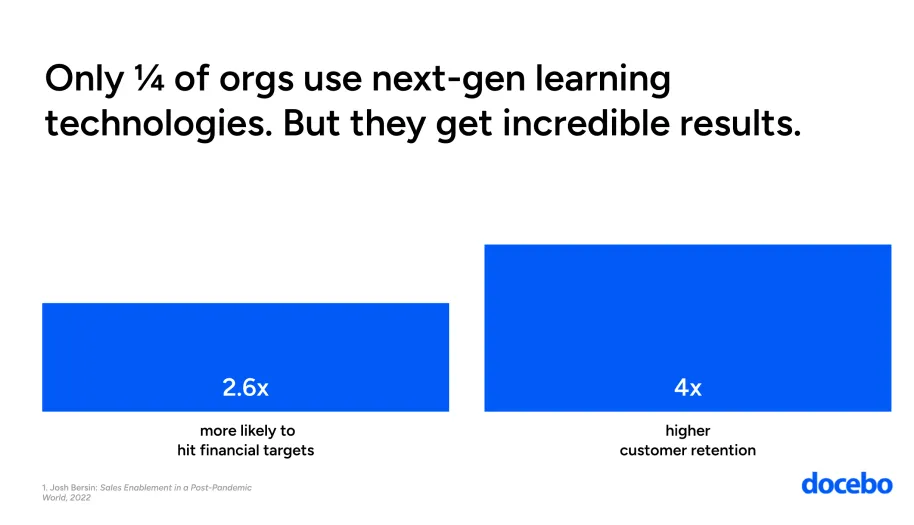The Learning Landscape
The state of L&D
The L&D industry is at a massive inflection point. The most pressing business challenges are all related to learning—so leaders are looking at L&D to solve them. It’s a unique moment.
Consider: The two biggest barriers to business transformation are skill gaps and an inability to attract talent[1]. CEOs are up at night, worrying about the talent supply chain (it’s their #1 concern)[2]. Six in 10 workers will need retraining in the next three years—but only half of them have access to the training they need. It sounds alarmist to identify this moment as a ‘skills crisis;’ but it’s certainly a fitting description.
L&D has never been more important. But it’s never been easier to get wrong. And despite record budgets (about $1400/employee in large companies[3]), many practitioners aren’t delivering on L&D’s big promise.
What’s the problem?
Surprisingly, budget is not the bottleneck and hasn’t been for years: Companies with adaptive learning teams spend 27% less on L&D and deliver far greater business outcomes. And high-performing customer education programs deliver 300% better results—at only 9% higher cost.
You can’t spend your way to exceptional learning. In fact, if an organization’s goal is to be a leader in learning, a big budget isn’t necessary or sufficient.
L&D succeeds when it’s prioritized. But only 15% of large global companies say they grant corporate learning the high priority it deserves and less than 15% of leaders believe that learning constitutes a core part of their company’s overall business strategy.
| 2021 | 2023 | Net change | |
|---|---|---|---|
| ‘Our L&D strategy is aligned with our organizational priorities.’ | 77% | 67% | -10% |
| ‘Leaders recognize the impact of L&D’ | 81% | 67% | -14% |
| ‘We are clear about how L&D can drive business value’ | 71% | 61% | -10% |
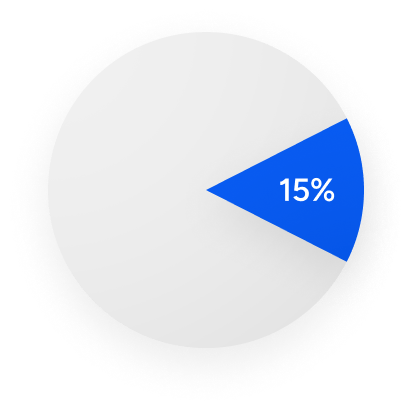
- Only 15% of leaders believe learning is a core part of their business strategy.
- Only 15% of companies say they give learning the high importance it deserves.
When it’s done well, L&D can be a powerful driver of everything an organization could want:
Skilled employees who are more productive and stay longer, loyal customers who advocate for your brand and spend more money, and well-trained partners who help you sell and innovate.
But to deliver on these promises, L&D leaders need to show business stakeholders—boldly—that L&D is the single best solution to their most pressing challenges.
Those challenges fall into several broad buckets:
- Talent and skills
- Navigating the AI revolution
- Scaling into the future
Talent and skills
Skill gaps are the #1 barrier to business transformation—more than funding, more than regulations, and more than inflation. In IT, for example, more than 52% of global leaders say they’re already feeling the pain of a skills shortage. That number will grow to 90% by 2027.
More than people, culture, or innovation, organizations need skills to function. For the first time in history, completing a skill assessment is more important than completing a university degree for candidate selection[4].
However, a narrow focus on ‘winning’ talent is the wrong approach.
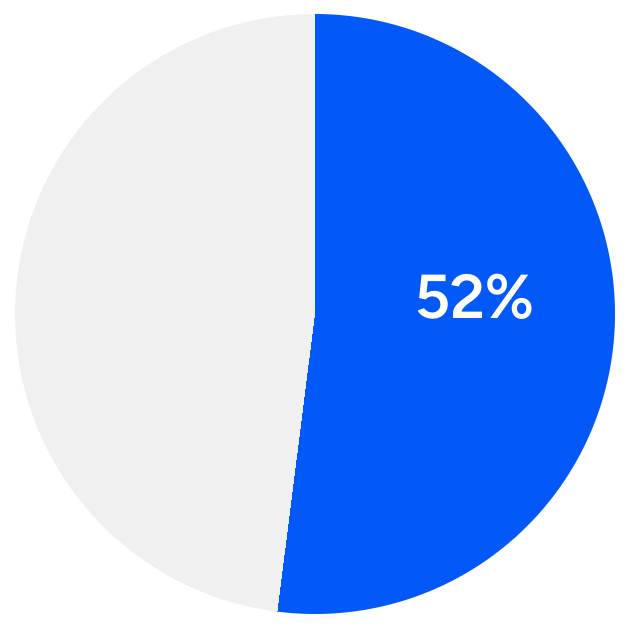

Most IT leaders are already feeling the pain of a skills shortage. And this trend is just getting started.
When you fight a war for talent, you get beat up.
You can’t hire your way out of a skills gap. You need to grow talent from within.
At the current rate of skill disruption (44% in the next five years), trying to hire your way out of a skills gap is a myopic (and expensive) solution. No matter how skilled new hires are, their skills will be outdated before their second holiday party.
Becoming a constantly-churning treadmill of talent isn’t an option. A systemic problem requires a systematic solution. Businesses need to nurture and educate their talent and build desired skills from within.
This strategy will also boost retention—a variable more than nine in 10 of organizations are concerned about. Of the top five factors that cause employees to leave their jobs, three are learning-related. And more than a third of employees would leave their current company if they weren’t offered training on new skills.
Creating an L&D function that’s adept at skills building isn’t just a solution to the single most pressing business challenge—it’s also a way to elevate your talent strategy. Over the next few years, the organizations that win will be the ones that act on this fact.
Navigating the AI revolution
Is AI going to transform every aspect of business, or is it massively overhyped?
The answer to both is ‘yes.’
Yes, the hype is superlative. But a lot of it is justified. Broadly, Enterprise AI initiatives are expected to boost productivity and creative problem solving by 50%[5].
What about in L&D?
| Task | Improved efficiency w/ generative AI |
|---|---|
| HR strategy and planning | 10-25% |
| Recruiting and resourcing (incl employer branding) | 25-50% |
| HR admin and shared services (incl onboarding) | 25-50% |
| Learning and development (L&D) | 10-25% |
| Performance and career management | 10-25% |
| Employee engagement (retention management, DEI, change management) | 10% |
Generative AI has barely been available for a year, and already most HR leaders agree they’ll be falling behind if they don’t adopt and implement it in the next 12-24 months. That’s not a lot of time.
Meanwhile, workers have already adopted AI. 80% of digital workplace leaders say employees are using generative AI in their job duties today—even though most organizations have no guidelines around its use[7].
This trend will accelerate the digitalization of L&D. But Generative AI has its challenges, too. It can hallucinate and present incorrect information as fact, it can recapitulate biases and prejudices from its training data, and it can be difficult to inspect (the ‘black box’ problem). Plus, most mainstream generative AI tools are trained on data from the internet, which often contains copyrighted material.
The risks are real. But AI is both too complex for an organization to build on their own and too powerful to simply ignore.
For these reasons, L&D teams are increasingly partnering with vendors who have a history of independent AI expertise. It’s important that the AI solution you choose is pedagogically sound and can incorporate your business’ training materials (like specific product documentation). This makes it possible to generate effective learning materials for real business needs—not the generic content often spit out by mainstream models like Chat-GPT.
There’s no going back: AI is here, it’s real, and everyone must prepare for it. To ignore the opportunity and impact promised by AI would be a catastrophic mistake.
Scaling into the future
There’s an interesting negotiation happening between the C-suite and L&D. At the top of this piece, we said that only 15% of large global companies grant corporate learning the high priority it deserves.
That’s changing.
In 2020, learning and training was an ‘Employees Only’ zone. Only 27% of organizations trained external audiences (like customers and partners). In 2023—just three years later—that number has tripled to 77%.
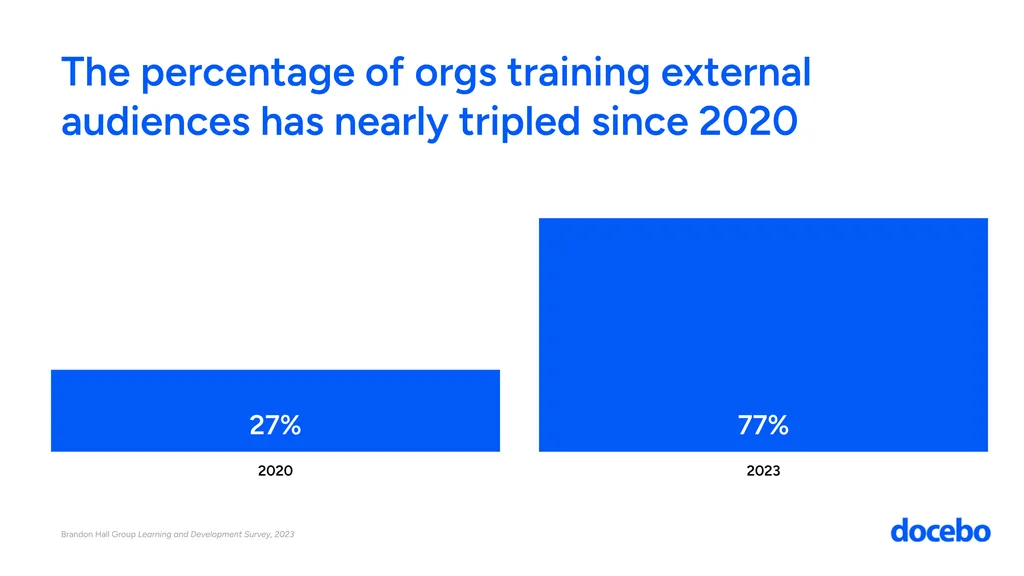
This is an amazing stat. Launching an external education program isn’t a trivial task; it’s a huge undertaking and accomplishment.
It’s paying off. Nine in 10 organizations are already getting value from their customer education programs and the same number plan to increase their investment next year. So, what are organizations getting for this investment?
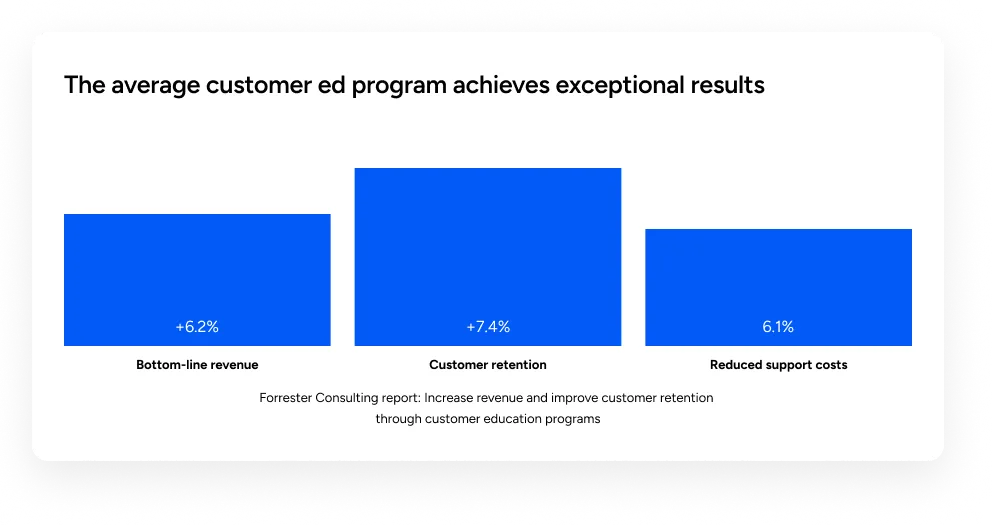
The numbers don’t lie. Customer education is a money-maker on both sides of the profit equation: It increases revenue and reduces costs. These impacts are also easy to measure and attribute because they connect to stats every business is already monitoring: Customer attrition, NPS, revenue, support costs, etc.
The incredible success of customer education teaches us this: When learning makes an obvious, clear, and measurable impact on key business KPIs, companies invest in it.
The law of L&D investment:
An organization’s learning program scales to the degree it can demonstrate business impact—and no further.
This law explains why learning programs were limited to employees for so long and then suddenly exploded to serve customers as well. The traditional metrics of L&D don’t clearly connect to business value:
How much are five points of ‘employee engagement’ worth?
How much more budget should an L&D team get if they increase ‘time spent learning’ by 10 minutes/week?
But as soon as the function connected itself to business value (like we see with customer education), it started getting more attention and priority.
This trend continues. For L&D programs to scale, they need to demonstrate tangible business impact in a direct way. For that reason, we expect partner education to be the next big priority. The appetite is there: Nearly three-quarters of partners complain about overly complicated partner programs and say they want increased support, transparency, and predictability. More than six in 10 (61%) say they have insufficient strategic guidance[8]. It’s a relationship begging for positive disruption.
Is there any doubt that training partners is good for business performance? No. And once a critical mass of businesses deploy partner training programs—and reap the benefits—other organizations will follow suit.
This dynamic is a big part of why 82% of global leaders believe HR and learning are more important now than they’ve ever been—while simultaneously believing that learning doesn’t get the priority it deserves. The function must earn the C-suite’s attentional bandwidth with business results.
Barriers to scale
Scaling a learning program is one of the single best investments a business can make. But that doesn’t make it easy. The most common barriers are content, personalization, and technology.
On the content front, scaling into new audiences means a new set of hungry minds to feed. But there are economies of scale.
While your sales team might need bespoke content about how to position and sell your product, most of your product training will be audience-agnostic. After all, customers, employees, and partners all need to understand how your product works and what its main benefits are.
| Metric | With Generative AI |
|---|---|
| Deliver high-quality L&D video content | 60% cost savings |
| Deliver high-quality L&D video content | 90% less time |
| Required team size per task | 50% fewer people required per task, freeing up team members for new initiatives |
However, it still takes over 100 hours to build an hour of elearning content. And if that content is highly engaging (with gamification or interactivity), that number climbs to over 450 hours[9]. Fortunately, generative AI is projected to cut these costs significantly.
Next, personalization. High-performing organizations are 1.5x more likely to create personalized learning experiences that are tailored to their learners[10]. It’s a critical pillar of success—and again, it’s time consuming.
But get this: Today, 54% of L&D teams only cater their content to a generic audience[11], and 67% say that it isn’t personalized enough for customers[12].
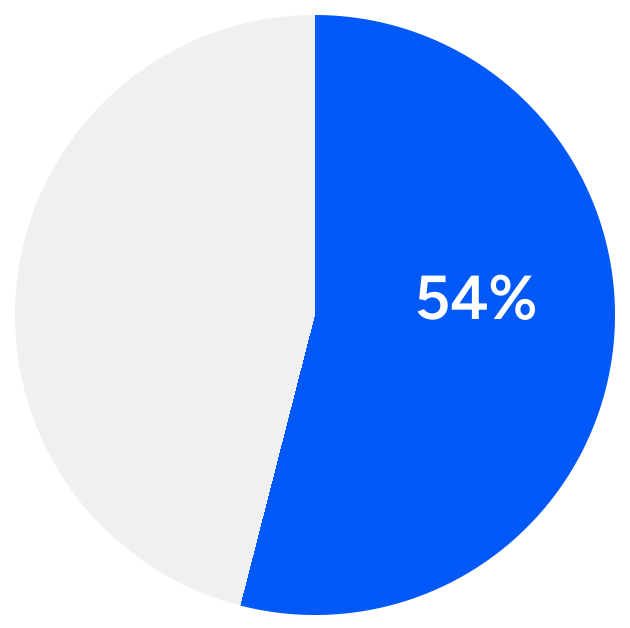
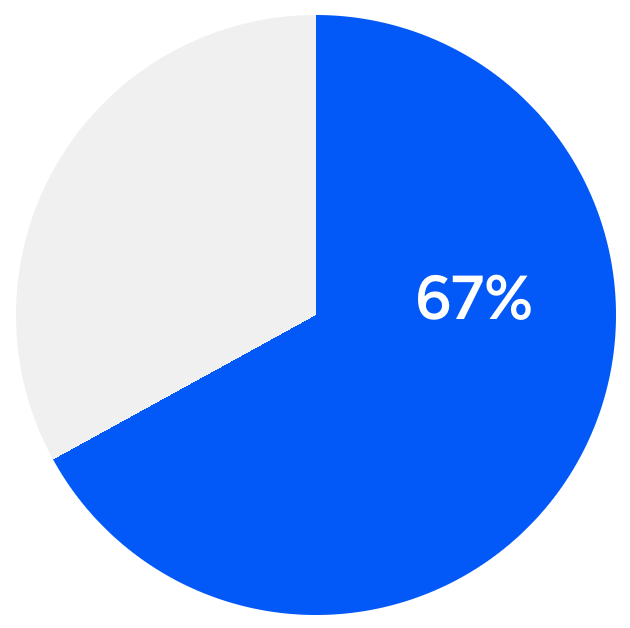
54% of L&D teams only build content for generic audiences. 67% say it’s a problem.
Again, technology is positioned to help. Very few organizations are using AI to drive the personalization of learning content, representing a significant opportunity for the function in general.
These trends suggest that content creation, curation, and personalization will become easier and more affordable. The burden of content and personalization shouldn’t dissuade businesses from scaling into new audiences.
Finally, there’s the challenge of integrations. In 2022, the average business was using 120 SaaS platforms[13], doubled from just a few years prior. This level of technology proliferation leads to tech bloat, inefficiency, and redundant spending.
We’ve seen a contraction in the ‘new technology’ appetite of CFOs, IT teams, and Procurement departments. If a platform doesn’t make an organization’s tech ecosystem simpler—by replacing multiple tools or bridging disparate systems—it will not be considered by many companies. For the tech stack at least, the industry is reaching peak complexity.
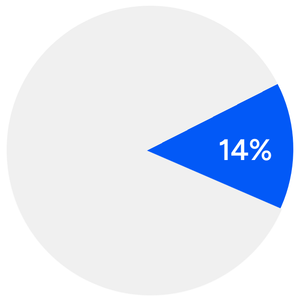
Next steps
The most pressing business challenges are all learning challenges. L&D directly impacts talent, skills, retention, and productivity—and it’s become clear that training customers and partners is an incredible value unlock.
However, L&D isn’t currently delivering its massive promise.
It’s not a problem of capability. L&D can solve most business challenges. And it’s not a problem of spending. Increasing budgets only have a moderate impact on L&D results.
It’s a problem of prioritization.
Overwhelmingly, businesses don’t give L&D the attention it deserves and L&D is rarely a core part of their business strategy.
To solve this, there are two things that need to happen.
First, L&D practitioners need to get better at showing the business impact of learning. There’s a deep, rich story to tell here. And with AI unlocking massive gains in productivity, it’s easier than ever to tell.
Second, business leaders need to recognize the profound impact L&D is already having on their business. They need to realize that there is no path forward—on talent, on skills, or on productivity—without a robust learning program.
Achieving these two goals is the purpose of this toolkit—and the prerequisite for learning success in 2024 and beyond.
